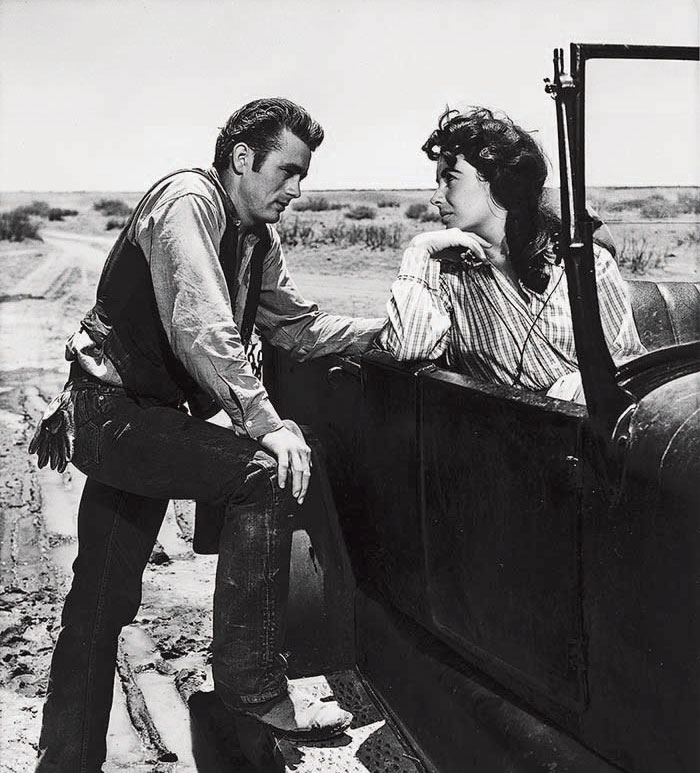George Stevens’ epic 1956 film not only made a box office splash, it changed Texans’ minds about the rich novel from which it was adapted.
When Edna Ferber published Giant, her aptly titled 1952 novel about proud cattle barons, nouveau riche oil tycoons, and strained race relations in Texas, she found many residents of the Lone Star State were initially slow to accept her literary effort. Indeed, hordes of image-conscious Texans were by turns appalled and enraged by Ferber’s rendering of larger-than-life characters — based largely on real-life figures — who appeared to embody every awful cliché about crude behavior and wretched excess in their beloved state.
Speaking for thousands of his angry readers, Houston Press columnist Carl Victor Little proclaimed that Ferber — whose previous novels had included So Big (a 1924 Pulitzer Prize winner), Show Boat (1926), and Cimarron (a 1929 book that was adapted into the Oscar-winning 1931 western film) — had written a “gargantuan hunk of monstrous, ill-informed, hokum-laden hocus-pocus.” Ferber claimed she had done weeks of on-location research to provide a factual underpinning for her fiction. But as Don Graham notes in his indispensable book Cowboys and Cadillacs: How Hollywood Looks at Texas, “For a while, a joke circulated that Ferber had done her research on Texas by having a commercial plane fly low over the state.”
And when it was announced that director George Stevens, fresh from the success of Shane (1953), would be turning Giant into a major motion picture with an all-star cast, Graham reported that “a man in Beaumont told a Hollywood columnist, ‘If you make and show that damn picture, we’ll shoot the screen full of holes.’ ”
But when Warner Bros. released the nearly three-and-a-half-hour film version of Giant in 1956, there were no reports of gunfire in Texas movie theaters. In fact, Texans by and large were so dazzled by the star power of Elizabeth Taylor, Rock Hudson, and the recently deceased James Dean — and so impressed by the way Stevens, screenwriters Fred Guiol and Ivan Moffat, and an army of Hollywood craftsmen celebrated all that was big and bold about the Lone Star State — that they set aside (or conveniently forgot) any lingering ill will toward Ferber and fervently embraced the movie.
It should be noted, of course, that much goodwill had been generated while a considerable portion of Giant was shot on location in Marfa, Texas, where residents were invited to witness filming, work as extras, and view dailies screened in the local theater.
The reaction outside of Texas was equally enthusiastic. Giant earned Stevens his second Oscar as Best Director, made more money at the box office than any other Warner Bros. production up to that point — it was not surpassed until Superman took flight in 1978 — and was applauded by film critics for the scale of its story and the ambition of its storytelling. Chief among its champions: Bosley Crowther of The New York Times, who praised Giant as “a tremendously vivid picture-drama” that arrestingly recounted “how oil exaggerated and confused the virtually feudalistic ways of living of the old Texas landowners and cattlemen. It visions the change of social standards from rugged individuality to the massive and vulgar acceptance of running in plutocratic herds.”
Covering a period from the 1920s to the post-World War II years, Giant is a sprawling and spectacular saga that focuses on the intersecting lives of Jordan “Bick” Benedict Jr. (Hudson), the tradition-bound owner of the Reata Ranch, a massive spread of “around a half-million acres” in West Texas; Leslie Benedict (Taylor), his Maryland-born wife, who takes a while to acclimate herself to the rigors of Texas ranch life but never fully accepts the casual racism (directed at Mexican laborers and neighbors) or ingrained sexism of her husband and his good-ol’-boy buddies; and Jett Rink (Dean), a moodily insolent ranch hand who is bequeathed a small patch of land by Bick’s spinster sister, Luz (Mercedes McCambridge), and becomes a zillionaire when he strikes oil on his property.

Slowly but surely, with a good deal of prodding by his wife, Bick becomes more racially enlightened, especially after his son, Jordan Benedict III (Dennis Hopper), marries a Mexican-American beauty, Juana (Elsa Cárdenas), and fathers Jordan Benedict IV. But Jett — a character Ferber modeled after real-life super-rich Texan Glenn McCarthy — is never fully satisfied after amassing his immense fortune and continues to nurse his unrequited crush on Leslie even after he starts to woo her daughter (Carroll Baker).
Six decades after its initial release, Giant can be viewed as a strong influence on everything from the prime time soap operas Dallas (both the original and the reboot) and Dynasty (which briefly featured Rock Hudson as a series regular) to movies as diverse as Kevin Reynolds’ Fandango (in which a young Kevin Costner and some friends visit Marfa to see the crumbling remains of the Reata ranch house set) to Robert Altman’s Come Back to the Five and Dime, Jimmy Dean, Jimmy Dean. (Dean died in an auto crash less than a week after completing his work on Giant; during post-production, director Stevens employed actor Nick Adams to re-dub some of his dialogue.)
And nowhere is it treasured more than in the Lone Star State, where it remains known as “the national film of Texas.” The reason for its enduring appeal? According to Don Graham: “The moral equation of Giant is the most sentimental and cherished in Texas mythology: a preference for the ranching tradition as against the wheeler-dealer world of wildcatters and gushers. As a modern western, Giant succeeded so well because it affirmed for Texans and the nation the old-fashioned virtues of pastoral ranching, cowboying, yes-ma’aming and no-ma’aming, [and] raising prize-winning cattle on the open plains.”
From the November/December 2016 issue.














